In this May 11, 2016 photo, a taxi drives past the Cuauhtemoc Housing Unit and a municipal sign with a message that reads in Spanish; "Building the new Acapulco" in Acapulco, Mexico. The city's latest wave of killings began April 24, when bursts of gunfire broke out along the coastal boulevard. The murder rate in this city of 800,000 hit 146 per 100,000 inhabitants in 2012. It has since fallen to about 112 per 100,000, but that remains far higher than nationwide levels. (AP Photo/Enric Marti)
The Associated Press
ACAPULCO, Mexico (AP) - Along with beach towels or sandals, there's a new popular beach accessory that says a lot about the violence gripping this once-glamorous resort: a small black leather tote hanging from the neck or shoulders of some men. It's not a man-bag, exactly; it holds a small pistol.
"When I saw you guys standing outside my office, I almost went for my bag," said one businessman who lives in terror after getting death threats and extortion demands by criminal gangs at his office four blocks from the water. "I'm in fear for my life."
Death can strike anywhere in Acapulco these days: A sarong vendor was slain on the beach in January by a gunman who escaped on a Jet Ski. Another man was gunned down while enjoying a beer at a seaside restaurant. In the hillside slums that ring the city, a 15-year-old girl's body was found chopped into pieces and wrapped in a blanket, her severed head in a bucket nearby with a hand-lettered sign from a drug gang.
The upsurge in killings has made Acapulco one of Mexico's most violent places, scaring away what international tourism remained and recently prompting the U.S. government to bar its employees from traveling here for any reason.
In response, Mexico has lined the city's coastal boulevard with heavily armed police and soldiers, turning Acapulco into a high-profile test case for a security strategy that the government has used elsewhere: When homicides spike, flood the area with troops.
Today it's almost easier to find a truck full of soldiers, a federal policeman or a gaggle of local tourist cops than it is to find a taxi along the "costera," the seaside boulevard that runs through the hotel zone. Marines patrol the beach, while federal police watch over the breakwaters.
"This area has been made bulletproof," Guerrero state prosecutor Xavier Olea said.
Except it hasn't. A week after AP reporters visited, gunmen shot to death three young men in broad daylight two blocks away from a restaurant where they met with an underworld figure. Two of their bullet-ridden bodies lay on the concrete just off the beach, and one bled out on the sand. Two were waiters, and the third a roving coconut oil vendor.
On a recent day, farther down the beach, another black bag hung around the neck of a man nicknamed "the lieutenant." He works as a bodyguard for a man with underworld connections who agreed to meet near an open-air restaurant to discuss the security situation. He spoke on condition of anonymity to avoid being targeted by rivals or authorities.
"There are 300 paid killers on the costera," the underworld figure said, gesturing expansively over plates of fried fish and shrimp. At least one other bodyguard was nearby. "A decent killer makes about 5,000 pesos ($275) a week."
Experts say Acapulco shows the limitations of the government's security strategy. Federal police, almost none of whom are from the city, quickly get lost once they leave the coastal boulevard and ascend into twisting, hillside neighborhoods. Their heavy weapons are ill-suited to urban policing, and they're hampered as well by Mexico's unwieldy judicial system and a lack of investigative training.
Last week two men were shot and wounded on the street a block from the popular Caleta beach. Police showed up, but when no ambulance arrived, relatives or friends simply bundled the men into private vehicles to take them to the hospital. Police marked spent shell casings with cut-off plastic soda bottles, but there was no sign of any in-depth investigation.
"It's the same problem in Guerrero, the same problem in Tamaulipas, in Michoacan," security analyst Alejandro Hope said, referring to three states where homicides have spiked. "Suddenly there's an emergency, they send troops to where the problem is and in the short term crime drops. But then there is an emergency somewhere else, and then the troops have to leave, and they have not developed local law-enforcement capacity."
Acapulco's latest wave of killings began April 24, when bursts of gunfire broke out along the coastal boulevard. It was the first time such sustained shooting had been seen there since the darkest days of 2012, when the murder rate in this city of 800,000 hit 146 per 100,000 inhabitants. It has since fallen to about 112 per 100,000, but that remains far higher than nationwide levels and appears to be on the rise again.
Both prosecutor Olea and the underworld figure agree the conflict started late last year between the Beltran Leyva gang, which used to control the city, and the Independent Cartel of Acapulco, or CIDA, which arose following the death of cartel boss Arturo Beltran Leyva in 2009.
The Beltran Leyva family, now supported by Mexico's fastest-rising cartel, the Jalisco New Generation gang, tried to reassert control in November, calling themselves "La Empresa," or "The Company," and employing a small group of professional killers known as the Russians.
The Beltran Leyvas quickly antagonized the CIDA by cutting pay in half for enforcers and dealers, resulting in an open war. It is suspected that the waiters and the coconut oil vendor killed last week were innocents with no drug connections, allegedly slain by the Russians just to bring heat on the local gang.
Street-level drug dealing may well be second only to Acapulco's much-diminished tourism industry for the amount of money involved. A so-called Oxxo - local slang for a drug retail house, borrowed from the name of a ubiquitous convenience store chain - can do an estimated 150,000 pesos ($8,100) in business in a single night. The underworld figure said there are about 50 such "stores" in Acapulco, meaning that drug sales probably amount to about 7.5 million pesos ($400,000) per day.
That pays for a lot of hitmen.
The April 24 shootout came just after mysterious text messages circulated among city residents warning of a bloody weekend, prompting many to stay off the streets and keep their kids home from school.
State authorities initially described it as a direct attack on police installations, but as more information emerged it seems to have resulted from an attempt by unknown attackers to rob a drug gang payroll of about 50 bundles of cash, each containing thousands of pesos.
After the first shots were heard on the coastal boulevard, federal police in their underwear began firing from a nearby hotel where they were staying. Farther down the road, another hotel had its facade sprayed with bullets.
The police reaction, captured in online videos of loud, staccato gunfire, worsened the public perception of violence in Acapulco. About 1,600 businesses in the city have already closed due to security problems, said business chamber leader Alejandro Martinez.
"There is a lot of mystery about what happened (in the shootout), but whatever they did, they did it badly," Martinez said of security forces. "That was an error on the part of the federal government that cost us a lot."
He added that the drop-off in tourism has hit business owners already dealing with extortion demands from the gangs.
"First they send text messages," Martinez said. "Then come the phone calls, and if you don't pay, they come to your business, four or five men, asking for the owner."
There have been targeted killings of business owners, and also collateral damage: One waiter at a downtown restaurant was killed by a stray bullet during a gun battle.
Joaquin Badillo, who runs Acapulco's leading private security firm, estimated that 95 percent of the killings in the city are linked directly or indirectly to criminal gangs.
"Somebody didn't live up to a deal, somebody didn't pay, somebody didn't deliver, somebody was given (drugs) to sell and didn't, somebody else went to work for the competition," Badillo said. "None of these people are doing Acapulco any good."
But that's little comfort to residents of Acapulco's slums, who still suffer the worst of the violence despite the high-profile tourist-quarter killings.
New police chief Max Sedano said he thinks the gangs "have retreated up into the 'colonias,'" or slums, where few tourist dollars ever arrive.
In one, Ciudad Renacimiento, soldiers in battle gear guarded the chained gates of the Gabriela Mistral grade school on a recent day while mothers waited outside to pick up their kids. Like many schools in Acapulco, security was stepped up after gang members demanded teachers hand over year-end bonuses or a cut of their paychecks.
A few steps away, Pedro Ramirez, 71, sat at the street stall where he sells kitchenware. Gesturing toward the soldiers, he said all is quiet during the day but the danger begins as soon as they leave.
"It's like there is a curfew, nobody goes out at night anymore," said Ramirez, who has lived in the slum since its beginnings in 1980. "In the morning, dead people turn up on streets."
___
An earlier version of this story referred to the police chief as Max Saldana. He is Max Sedano.
In this May 9, 2016 photo, forensic workers remove the body of a man shot four times in an empty lot between residences in the Leyes de Reforma neighborhood of Acapulco, Mexico. Joaquin Badillo, who runs AcapulcoÃs leading private security firm, estimated that 95 percent of the killings in the city are linked directly or indirectly to criminal gangs. ìSomebody didnÃt live up to a deal, somebody didnÃt pay, somebody didnÃt deliver, somebody was given (drugs) to sell and didnÃt, somebody else went to work for the competition,î Badillo said. ìNone of these people are doing Acapulco any good.î (AP Photo/Enric Marti)
The Associated Press
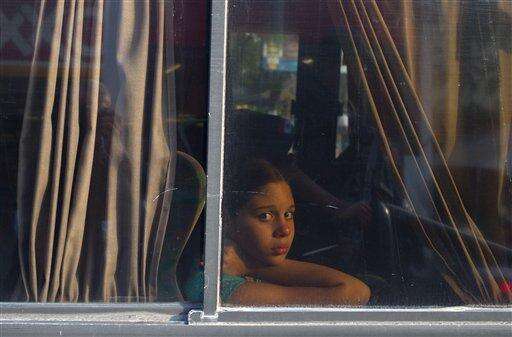
In this May 10, 2016 photo, a girl stares out a bus window during a routine police checkpoint on the âcostera,â the seaside boulevard that runs through the hotel zone in Acapulco, Mexico. Today itâs almost easier to find a truck full of soldiers, a federal policeman or a gaggle of local tourist cops than it is to find a taxi along the seaside boulevard. (AP Photo/Enric Marti)
The Associated Press
In this May 10, 2016 photo, a girl riding a bus puts up her hands as a local policeman conducts a routine search at a checkpoint along the âcostera,â the seaside boulevard that runs through the hotel zone in Acapulco, Mexico. An upsurge in killings has made Acapulco one of Mexicoâs most violent places, scaring away what international tourism remained. In response, Mexico has lined the cityâs coastal boulevard with heavily armed police and soldiers, but successes have been few. (AP Photo/Enric Marti)
The Associated Press
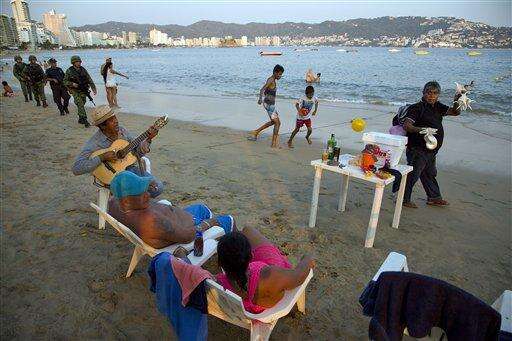
In this May 11, 2016 photo, a roving seashell vendor walks past as a street musician serenades a local couple and marines along with local police patrol the shore of Papagayo Beach, in Acapulco, Mexico. Experts say Acapulco shows the limitations of the governmentâs security strategy. Federal police, almost none of whom are from the city, quickly get lost once they leave the coastal boulevard and ascend into twisting, hillside neighborhoods. Their heavy weapons are ill-suited to urban policing. (AP Photo/Enric Marti)
The Associated Press
In this May 9, 2016 photo, a cross propped against a bullet-riddled building column marks the area where a policeman and taxi driver were gunned down in 2011, in Acapulco, Mexico. According to the date on the cross, one victim was 74-years-old. An upsurge in killings has made Acapulco one of Mexicoâs most violent places, scaring away what international tourism remained. (AP Photo/Enric Marti)
The Associated Press
In this May 11, 2016 photo, the fence separating the street from the Las Cruces neighborhood cemetery has been ripped open, in Acapulco, Mexico. Violence gripping this once-glamorous resort and its neighborhoods has seen an upsurge in the last months. According to estimates of local press more than 300 murders by gunfire have occurred in the city since the beginning of the year up to date. (AP Photo/Enric Marti)
The Associated Press

In this May 9, 2016 photo, the body of a man that could not be identified, lies in a pool of his own blood after he was shot dead at the entrance of a supermarket at the Las Cruces neighborhood in Acapulco, Mexico. Death can strike anywhere in Acapulco these days: A sarong vendor was slain on the beach in January by a gunman who escaped on a Jet Ski. Another man was gunned down while enjoying a beer at a seaside restaurant. In the hillside slums that ring the city, a 15-year-old girlÃs body was found chopped into pieces and wrapped in a blanket, her severed head in a bucket nearby with a hand-lettered sign from a drug gang. (AP Photo/Enric MartÃ)
The Associated Press
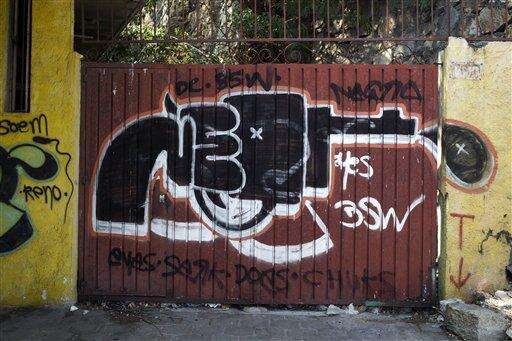
In May 10, 2016 photo, the gate of the once popular restaurant "Los Braseros" is emblazoned with a graffiti drawing of a gun, situated on the seaside boulevard, known as " La Costera", that runs through the hotel zone in Acapulco, Mexico. Mexico has lined the cityÃs coastal boulevard with heavily armed police and soldiers, turning Acapulco into a high-profile test case for a security strategy that the government has used elsewhere: When homicides spike, flood the area with troops. (AP Photo/Enric Marti)
The Associated Press
In this May 13, 2016 photo, a fisherman tries to sell his fresh catch to beach goers on Caletilla beach in Acapulco, Mexico. Violence gripping this once-glamorous resort has upsurged in the last months scaring away what international tourism remained. (AP Photo/Enric Marti)
The Associated Press
In this May 12, 2016 photo, young boys watch from a park as federal police inspect the crime scene where a man was shot in the El Coloso neighborhood of Acapulco, Mexico. Death can strike anywhere in Acapulco these days: A sarong vendor was slain on the beach in January by a gunman who escaped on a Jet Ski. Another man was gunned down while enjoying a beer at a seaside restaurant. In the hillside slums that ring the city, a 15-year-old girlâs body was found chopped into pieces and wrapped in a blanket, her severed head in a bucket nearby with a hand-lettered sign from a drug gang. (AP Photo/Enric Marti)
The Associated Press
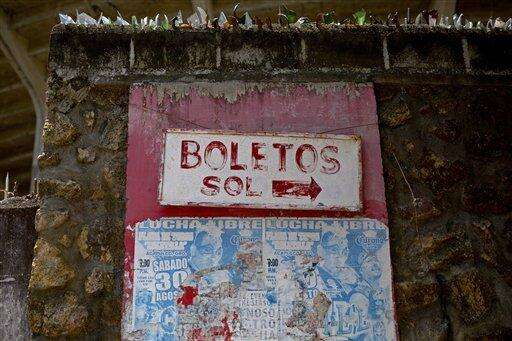
In this May 12, 2016 photo, shards of glass set into mortar serve as a crime prevention device on a wall displaying a directional sign on where to buy tickets at the Plaza de Toros Caletilla bull fighting ring in Acapulco, Mexico. Once the stage for renowned bullfighters the ring has been closed since 2014 due to the violence that has driven international tourism away in last years. (AP Photo/Enric Marti)
The Associated Press

In this April 23, 2016 photo, members of the Lucha Libre wrestling group who call themselves, "Guerreros del Cuadrilatero-Club Soley"or Club Soley Wing Warriors, train for a show on the back patio of a barbershop in the Las Cruces neighborhood of Acapulco, Mexico. Residents of Acapulcoâs slums suffer the worst of the violence despite the high-profile tourist-quarter killings. New police chief Max Saldana said he thinks the gangs âhave retreated up into the âcolonias,ââ or slums, where few tourist dollars ever arrive. (AP Photo/Enric Marti)
The Associated Press
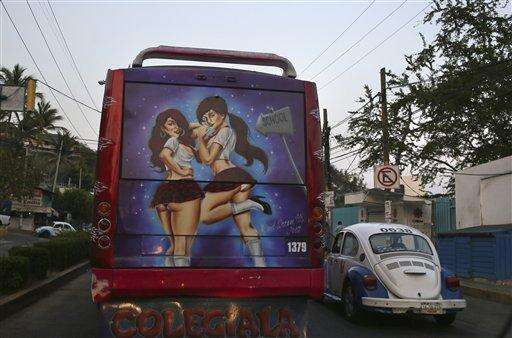
This May 11, 2016 photo shows the backside of a bus decorated with a provocative mural, in Acapulco, Mexico. Today itÃs almost easier to find a truck full of soldiers, a federal policeman or a gaggle of local tourist cops than it is to find a taxi along the ìcostera,î the seaside boulevard that runs through the hotel zone. Marines patrol the beach, while federal police watch over the breakwaters. (AP Photo/Enric Marti)
The Associated Press
This May 12, 2016 photo shows a sign advertising a boxing school with a message that reads in Spanish; "Come on up and learn to defend yourself," alongside a road leading to the marginal neighborhoods of Acapulco, Mexico. The upsurge in killings has made Acapulco one of MexicoÃs most violent places, scaring away what international tourism remained and recently prompting the U.S. government to bar its employees from traveling here for any reason. (AP Photo/Enric Marti)
The Associated Press

In this May 13, 2016 photo, a woman talks on a phone over a wounded Edgar Osvaldo Vega, as Pedro Gracias sits in a car bleeding, waiting for assistance after being shot by unknown gunmen while driving near Caleta beach in Acapulco, Mexico. Police showed up, but when no ambulance arrived, relatives or friends simply bundled the men into private vehicles to take them to the hospital. Police marked spent shell casings with cut-off plastic soda bottles, but there was no sign of any in-depth investigation. (AP Photo/Enric Marti)
The Associated Press
In this May 11, 2016 photo, two burnt out Volkswagen Beatle shells, colloquially referred to as "Vochos", sit near an overpass on a road leading to the neighborhoods overlooking Acapulco, Mexico. According to neighbors the cars were set on fire about two years ago, during a shootout. (AP Photo/Enric Marti)
The Associated Press
In this May 9, 2016 photo, a Bible quote spray-painted on a bullet-riddled wall reads in Spanish; "And Jesus said; I am the resurrection and the life. He who believes in Me will live, even though he dies," at a former police outpost where police officers were shot in 2011 on a hill overlooking Acapulco, Mexico. AcapulcoÃs latest wave of killings began April 24, when bursts of gunfire broke out along the coastal boulevard. It was the first time such sustained shooting had been seen there since the darkest days of 2012, when the murder rate in this city of 800,000 hit 146 per 100,000 inhabitants. (AP Photo/Enric Marti)
The Associated Press